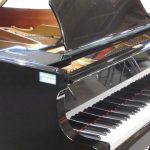
Chopin’s Grande Valse Brillante is a masterpiece characterized by its incredibly catchy melody and unexpected developments that surprise the listener. It’s often performed at recitals and concerts due to its widespread popularity.
Chopin composed a total of 19 waltzes, and among them, this one stands out as one of the most brilliant. Listening to it feels invigorating, and you might even find yourself imagining how it would feel to dance to this waltz if you had lived during Chopin’s time.
In this post, I’ll share tips on how to play Chopin’s Grande Valse Brillante skillfully and discuss its difficulty level.
Contents
Difficulty Level of “Grande Valse Brillante”

The Grande Valse Brillante is rated as “D (Upper Intermediate)” in the difficulty evaluation by the Zen-On Piano Piece series.
When examining the technical demands required to play it, there aren’t any extremely challenging sections typical of advanced-level pieces. However, there are numerous parts that are tricky to play accurately as written in the sheet music, making Zen-On’s evaluation feel fair.
I performed this piece when I was in the third year of middle school, meaning I had about ten years of piano experience when I took on the challenge.
I particularly struggled with the six-note repeated keystrokes of the same note in succession. This part, in my opinion, is one of the trickiest sections of the Grande Valse Brillante.
With a grand piano, where the hammer returns due to gravity, the key rebound is faster, making repeated notes easier to play. On the other hand, with an upright piano or an electronic piano, the keys return more slowly, so this section requires more dedicated practice.
A small tip for playing this section well is to minimize arm movement while using only your wrist to play, following the finger pattern 3→2→1→3→2→1. Keep your hand rounded and strike the keys as if plucking with your nails. By reducing unnecessary movements and ensuring clean strikes, the sound becomes crisper, and it’s easier to achieve a smooth, rolling motion.
Although this section is challenging, with repeated practice, your fingers will adapt, and you’ll surely be able to play it fluently. Practice makes perfect—keep at it, and master this section!
Waltzes in Chopin’s Works and “Grande Valse Brillante”
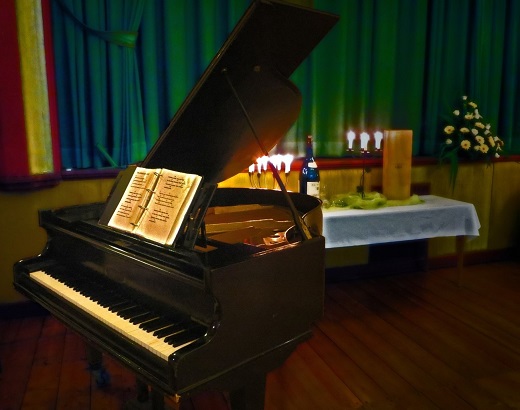
The era when Chopin composed the Grande Valse Brillante coincided with the time when Johann Strauss I’s Viennese waltzes were taking the world by storm.
For those of you who listen to the New Year’s Concert every year, you probably know that Johann Strauss I’s Viennese waltzes are truly uplifting, exciting, and filled with catchy melodies!
For example, Lorelei-Rheinklänge
is one of the most famous pieces representing the Viennese waltz. I highly recommend watching this video, especially to contrast it with Chopin’s waltzes.
While the Viennese waltz was all the rage, Chopin composed the Grande Valse Brillante. However, it seems that Chopin did not have a very favorable impression of Viennese waltzes.
As a result, even though Chopin’s waltzes belong to the same genre as Johann Strauss’s Viennese waltzes, they often have a distinctly different character.
Some of them are suitable for glamorous balls, but many are more refined, fitting for sophisticated social settings like salons. Others are too sorrowful to be appropriate for dancing.
For instance, Waltz No. 2 and No. 8 are relatively close to the general image of waltzes and can be considered suitable for dancing.
Here is a performance of No. 8:
On the other hand, Waltz No. 5 is a highly sophisticated piece. While it is bright, its rhythm is complex in parts, making it somewhat questionable as a danceable piece.
※ By the way, Waltz No. 5 adheres to the waltz form while also showcasing Chopin’s creativity and refined expressions. It is packed with musical delights, and I personally love this piece.
This recording is excellent as well, so please give it a listen!
Additionally, Waltz No. 3 does not feel like a piece composed for dancing. It reflects Chopin’s inner world and is an intensely melancholic piece.
So where does the Grande Valse Brillante fit among Chopin’s waltzes? I believe it is a result of Chopin composing a waltz with dancing as its primary purpose, much like Waltz No. 2 and No. 8.
For example, the high-pitched fanfare announcing the start of the waltz rings out, followed by a steady three-beat tempo that is consistently maintained. The rhythm, tempo, and phrasing feel conducive to dancing.
Additionally, after the first theme ends, seemingly unrelated themes are connected one after another. The sheet music explicitly instructs that these themes must always be repeated, which also seems to reflect consideration for dancing (as becoming familiar with the music on the second round makes it easier to dance).
Of course, even though the Grande Valse Brillante prioritizes practical utility for dancing over Chopin-like refinement and spirituality, this does not mean that it is an empty and dull piece of music.
For example, Rachmaninoff’s performance
and Fujiko Hemming’s performance
showcase an artistic quality that transcends a mere dance piece. Many such performances exist, each offering expressions that even we can incorporate into our own interpretations.
To give some specific examples, the above recording by Rachmaninoff ends the third beat (the part marked in red in the sheet music) with a crisp staccato. While this approach deviates from the written score, it leaves a very elegant impression.
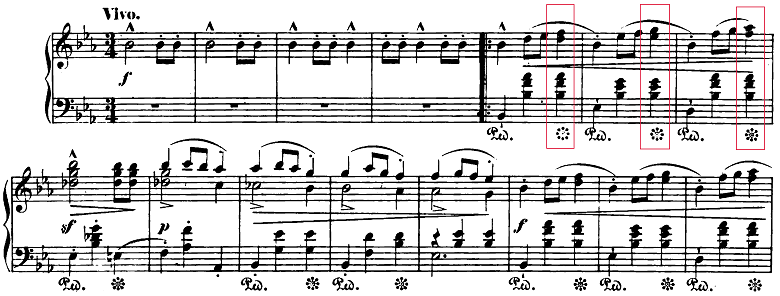
Also, the bold tempo shifts at thematic transitions provide another point of reference.
For instance, in the following sheet music, the part marked with a red circle (starting at 0:59 in the recording) is played with a significantly slower tempo.
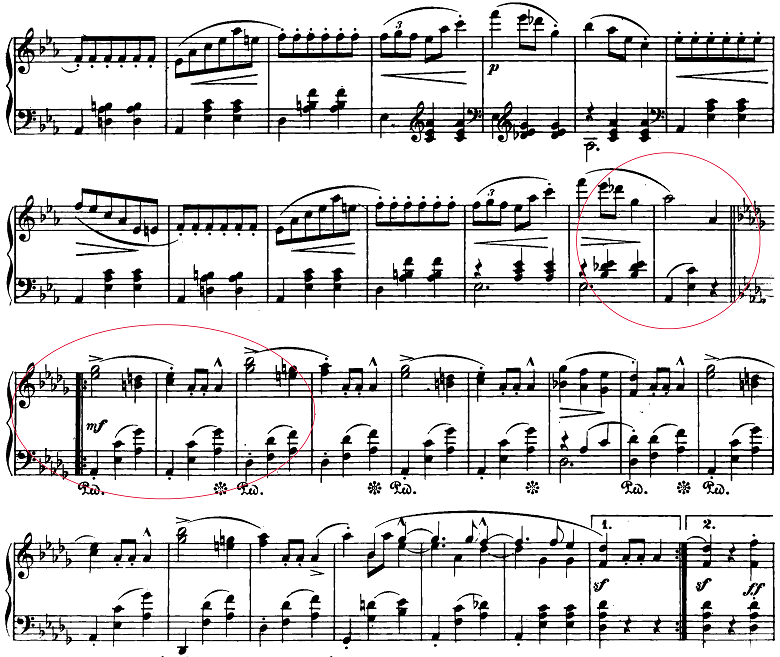
In contrast, the following closing section (starting at 3:41 in the recording) is played with a significantly faster tempo.
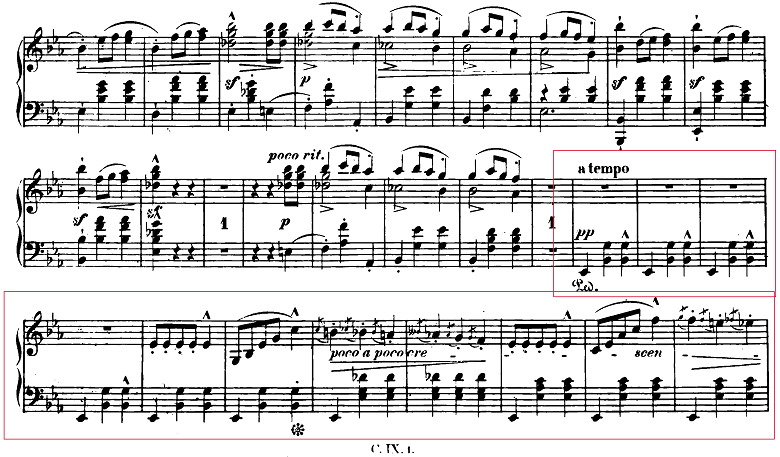
Such extreme interpretations are perhaps achievable precisely because it is Rachmaninoff! While there may be mixed opinions, for those struggling to make the piece feel less monotonous, there are certainly parts of these performances that can be referenced—perhaps by adopting a more moderate approach.
In summary, when performing the Grande Valse Brillante, maintaining a not-too-fast tempo and steady rhythm suitable for dancing, while incorporating refined expressions and playful touches inspired by earlier performances, can greatly enhance the piece’s charm!
How to Play and Difficulty Level of “Grande Valse Brillante”

1. The difficulty level of Grande Valse Brillante is rated “D (Upper Intermediate).” The frequent repetitions of the same note make it particularly challenging, requiring sufficient practice.
2. Chopin composed various waltzes, but Grande Valse Brillante emphasizes its aspect as a dance piece. Therefore, it is recommended to focus on a performance that captures the spirit of dancing. At the same time, incorporating Chopin’s refined expression and playful nuances will help bring out the charm of this piece.
That concludes our overview of how to play and the difficulty level of Chopin’s Grande Valse Brillante. Be sure to master it yourself!
- IMSLP (Sheet Music Link)
This article was created using this sheet music, published in 1878 by Breitkopf & Härtel and is in the public domain.
- How to Master Chopin’s “Grande Valse Brillante”: Difficulty Level and Essential Waltz Techniques 2017/6/2
- Play with Fingerings That Suit You! Chopin’s “Grande Valse Brillante” Difficulty and Tips for Playing 2017/6/29
- The World of Brilliant Waltzes! How to Play and the Difficulty Level of Chopin’s “Grande Valse Brillante” 2017/12/6 ←Currently Viewing Article
- Ranking Chopin’s Waltzes by Difficulty: A Piano Teacher’s Perspective 2017/3/17
- Perfect for a Piano Recital! Chopin's “Minute Waltz”: Difficulty and 3 Tips for Playing It 2017/5/25
- How to Master Chopin’s “Grande Valse Brillante”: Difficulty Level and Essential Waltz Techniques 2017/6/2
- Play with Fingerings That Suit You! Chopin’s “Grande Valse Brillante” Difficulty and Tips for Playing 2017/6/29
- How to Master Chopin's “Minute Waltz”: 8 Essential Tips and Difficulty Insights from a Mole 2017/7/6
- Master Chopin's “Waltz No. 7, Op. 64-2”: Tips, Tricks, and Difficulty Level Explained 2017/7/14
- Charming & Lyrical! Tips and Difficulty Level of Chopin's Waltz No. 14 in E Minor, Posthumous 2017/8/6
- Romantic Love! Chopin’s Waltz No. 9 Op. 69-1 Tips and Difficulty Level (“Farewell Waltz” or “Valse de l'adieu”) 2017/11/8
- The World of Brilliant Waltzes! How to Play and the Difficulty Level of Chopin’s “Grande Valse Brillante” 2017/12/6 ←Currently Viewing Article
- Chopin's Waltz No. 10, Op. 69-2: A Beginner’s Guide to Playing, Mastering, and Understanding Its Difficulty 2017/12/16
- Chopin’s Puppy Waltz Simplified: Easy Tips, Difficulty Level, and Playing Guide for Waltz No. 6 in D-flat Major, Op. 64-1 2018/3/9
- Chopin’s Waltz No. 15 in E Major: A Hidden Gem with Playing Tips and Difficulty Level Explained 2018/3/19
- Chopin’s Waltz No. 3 (Grande Valse Brillante) in A Minor, Op. 34-2: Difficulty and Playing Tips 2018/5/19
- Is Chopin’s “Minute Waltz” Hard? Learn 7 Tips to Conquer It Today 2019/8/1






